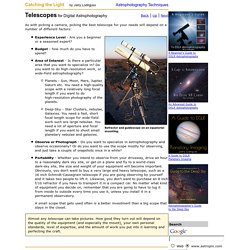

Ritwik Bhattacharjee
The McWetlog: Gearing up for astrophotography. All the positive feedback I’ve received for my recent attempts at lunar photography have made me more enthusiastic than ever about getting into astrophotography.

I’ve already got a few books on the subject; truth be told, there’s a bit of a learning curve. It’s going to take me a while to get good at this. And that’s not a bad thing, because astrophotography can be awfully expensive: it’s going to take me a while to assemble all the equipment required for a basic astrophotography rig that can do more than just photograph the Moon. I’ve already got two main pieces of equipment. I have a telescope geared towards astrophotographers: an 80mm Sky-Watcher Equinox apochromatic refractor, with really good colour correction (as far as I can tell) and a short (500mm, f/6.25) focal length. So, what else do I need? The first piece of equipment I’m likely to get is a Televue Powermate. . The one generating the most buzz is Orion’s inexpensive $280 (U.S.) autoguider.
Amateur Astronomers' Associations / Clubs in India. Astrophotography. Breakthrough Science Society. Offer Of The Week - Binocular Sale. Sky_watcher-india. Astrophotography - Guiding a Telescope for Imaging. We all do it -- ogle over the astrophotographs taken by the masters.

The deep-sky images look so exquisite with their masses of detail and perfectly round, pinpoint stars. We know they didn't come easily. Impressive celestial photography is a lot more feasible for amateurs now than it was a generation ago. But good results still require a willingness to learn the intricacies of cameras, focusing techniques, exposure times, films, and miscellaneous equipment.
In particular, taking deep-sky pictures requires a skill that's involved in no other kind of photography: guiding on a star. To get a sharp image from a long exposure, you must keep a guidestar centered on cross hairs for the entire time the shutter is open -- from a few minutes to an hour or more. No telescope drive, no matter how well made, can eliminate the need for guiding.
The aiming corrections required are so tiny -- just a few arcseconds -- that you cannot push the telescope by hand. Russell Croman Astrophotography. Telescopes for Astrophotography. As with picking a camera, picking the best telescope for your needs will depend on a number of different factors: Telescope Attributes - Telescopes are designed to gather light and bring it to focus so that the image can be examined in detail with an eyepiece, or recorded on film or with a digital camera.

Telescopes reveal fainter objects than can be seen with the eye because they gather more photons than the eye can gather. Smaller details can be seen because they also magnify objects. The nomenclature used to describe telescopes and camera lenses can sometimes be confusing. Telescopes are usually talked about in terms of aperture, while camera lenses are usually talked about in terms of focal length. Telescopes and camera lenses have three main numerical attributes that we are concerned with in describing them: Aperture - The aperture is the size of opening in the telescope through which the lens or mirror gathers light.
Optical System Types Refractive Optics In 1892 H. Create RSS Job Feeds from Job Searches. Find Entertainment & Media Jobs at VarietyMediaCareers, Variety's Career Site for The Entertainment Industry. Los angeles tv/film/video/radio jobs classifieds. Mandy's Film and TV Production Directory - television - video - broadcast. LA's only qualified Film, TV & Commercial Production Resource. CGPersia Forums. Avid Media Composer v5.0 + Keygen (Core) Nikon India Private Limited. Orion, The Hunter. The Constellation of Orion, the Hunter Orion is the most famous and distinctive constellation in the winter night sky.

Red-giant star Betelgeuse shines yellow in the upper left-center of the photo, and blue-white Rigel is at bottom center. Between Betelgeuse and Rigel are three distinctive, bright, second magnitude stars in a row, making up the belt of Orion. Diffuse faint red emission nebulae are also seen scattered throughout the image, including the Orion Nebula below the three belt stars, and the Rosette Nebula in the upper left hand corner of the photo. Exposure DataCamera: Nikon F3 Lens: 55mm f/2.8 Nikkor Macro F/stop: F/2.8 Exposure: Single 15 minute exposure Mount: Losmandy GM100EQ Polar-aligned German-equatorial mount Film: Kodak Ektachrome 200 Filter: Fog Filter Exposure start: 4:34 am Date: Oct 12, 1999 Location: Batsto, NJ.
Help.